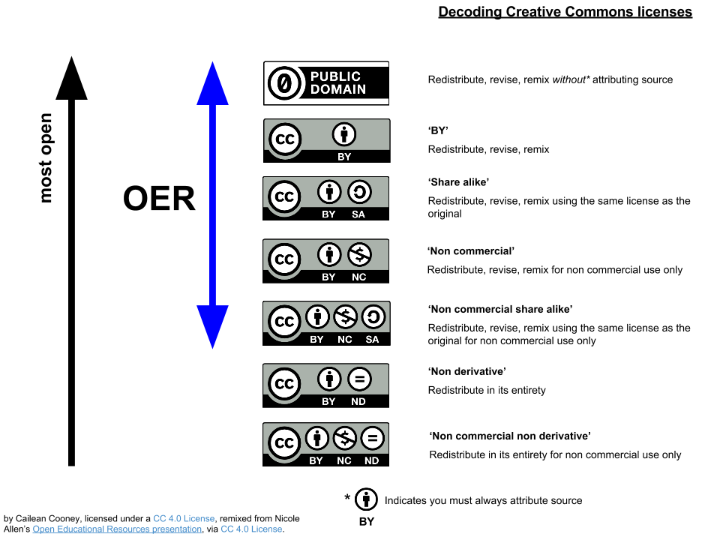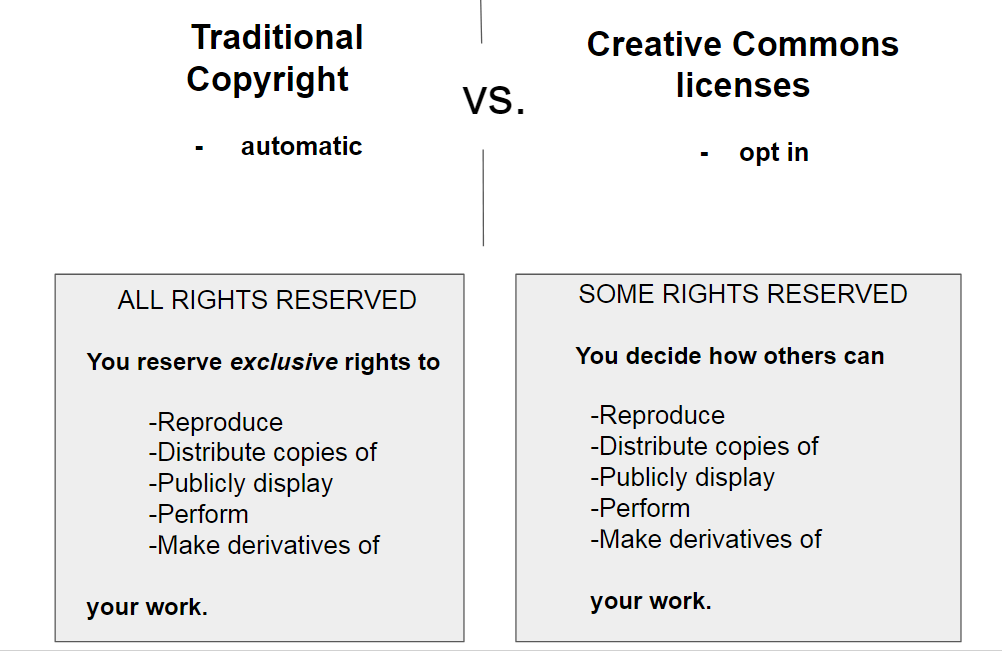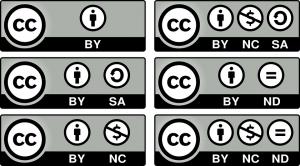Defining Open Educational Resources
Section contents
Defining the Term
You may have heard the term “OER,” and wondered – what exactly does it mean? OER refers to any educational content that is ‘free’ and ‘openly-licensed.’
- Free – No cost to use and keep; no exorbitant textbook prices
- Openly-licensed – When something is ‘openly-licensed,’ it means that the author/creator has explicitly made their work available for others to use, share, and adapt, typically by licensing the work with a Creative Commons license or other open-source license.
In other words, OER:
- Are teaching materials that can be shared freely and publicly, and
- Provide explicit legal permission to adapt the materials for customization
OER are often delivered in digital formats online, but they can be shared in print as well.
This type of “open” sharing is a newer model, different from what is permitted under traditional copyright. OER can increase access and equity by making course materials more readily available to students in a period when textbook costs are higher than ever.
Watch this 2 minute video about OER for a recap.
OER vs. free materials
What is the difference between learning material we describe as ‘OER’ and learning material we describe as ‘no-cost’ or ‘free?’
The critical thing that sets OER apart from cost-free resources is that they have what is colloquially referred to as “open licenses.” This means the author/creator has selected an intellectual property license that makes their work available for anyone to use, share, update, revise, and adapt. This means you don’t need to purchase a copy or contact the rights holder for permission to redistribute or adapt the work.
This is achieved by authors selecting a Creative Commons license for their work. These licenses provide a transparent way for authors to grant permission for users to:
- Retain – permission to own, archive, and make copies of the content
- Reuse – permission to reuse content in its unaltered form
- Revise – permission to adapt, adjust, modify, and alter content
- Remix – permission to combine original or revised content with other content to create something new
- Redistribute – permission to share copies with others in its original, revised or remixed form
(You may see this referred to as the ‘5 R’s’)
This type of “open” sharing is a newer model, different from what is permitted under traditional copyright.
Identifying learning materials that are OER
The way to determine if a learning material is OER is by looking for the intellectual property license. If you see it has a Creative Commons license that permits editing and remixing, then you can call it OER! We’ll go into more detail about the mechanics of this in the next section, but for now, to understand why open educational resources came about, it’s important to review intellectual property and current copyright law.
How Copyright Relates to OER
In order to talk in more detail about Creative Commons licenses – a widely used open licensing infrastructure in education and beyond – we first need to review copyright.
Section contents
Defining Copyright
Copyright is a form of protection granted by U.S. law to the creators of “original works of authorship” including scholarly and creative works. As part of this law, creators do not have to register their work or attach a copyright notice in order for copyright protection to apply to the work; the protection exists automatically from the time the work is created.
Rights protected under U.S. Copyright Law
Copyright holders have exclusive rights to:
- Reproduce their work
- Prepare derivative works
- Distribute copies of their work
- Perform their work publicly
- Display their work publicly
Copyright protections not only qualify for scholarly work (published and non-published), even napkin doodles are protected by copyright. Kind of counter-intuitive, right? An example of a learning object that one may not necessarily think of as being copyright protected is instructor PowerPoint slides.
Copyright law entitles you to retain five exclusive rights automatically. These automatic rights have implications for information dissemination (sharing). In fact, copyright law puts legal limits on how and to what extent a work can be used and distributed. This can make it challenging to integrate intellectual materials into educational settings.
Creative Commons
The more exposure you have to open educational resources, the more you will notice Creative Commons licenses.
What are the origins of “Creative Commons?” The Creative Commons organization was founded in 2001 by legal scholars, artists, and activists who developed and shared a legal framework, Creative Commons licenses, that runs parallel to U.S. copyright law so that authors of creative and intellectual materials could retain their copyright and decide how others use their work. They wanted to find some middle ground between the restrictions of traditional copyright and the ‘free wheeling’ public domain. This ethos is related to the free culture movement, the open source software movement, and the open access movement in scholarly publishing.
Read about the three layers (legal code, human readable, machine readable) that make up a C.C. license.
The image below relays some key distinctions among Creative Commons licenses in contrast to automatic copyright protections.
The image below shows the 5 icons that represent different components of C.C. licenses. As you search for open course materials, you will begin to notice these symbols.
Types of Creative Commons licenses
There are six distinct C.C. licenses to choose from. C.C. licenses are opt in, and each license provides you with a range of possibilities for how openly you want your work to be shared.
Important: For a learning material to be considered OER, these 5 permissions should be granted to potentials users / adopters of the material:
- Retain – the right to own, archive, and make copies of the content
- Reuse – content can be reused in its unaltered form
- Revise – content can be adapted, adjusted, modified, and altered
- Remix – original or revised content can be combined with other content to create something new
- Redistribute – copies of the content can be shared with others in its original, revised or remixed form.
The added affordance of being able to save or ‘retain’ a copy of the material and redistribute it makes it that much more stable for long-term use.
It’s important to recognize that not all Creative Commons licenses permit adaptation. Specifically, Non-Derivative (ND) licenses, do not permit adaption of the material.
The image below outlines the licenses on a scale of least to most restrictive permissions.

Summary
Traditional copyright protections have limitations on how intellectual work is shared. Creative Commons licenses are an opt-in alternative that runs parallel with copyright right law, but provides more choice for how your work gets shared.
As a creator of intellectual content, you can use the Creative Commons license chooser to help you decide what license makes sense for your work.
As an adopter of OER, you always need to attribute the work of others. This is a requirement when you redistribute the material as a PDF or other applicable file type (as opposed to linking out to the material). The added affordance of being able to save or ‘retain’ a copy of the material makes it that much more stable for long-term use. Just like you cite and provide references in your scholarship, when you teach with course materials developed by someone else, you should always attribute materials by displaying the name of the author and the C.C. license that accompanies the work. Learn more about attribution below.
Finding OER in your subject area
There are many resources available to identify OER which are outlined below.
Search for materials
- Search for OER
Search a variety of resources to locate OER in your discipline. - Browse OER by Subject
A curated list of OER specific to City Tech areas of study and organized by discipline / department and school: - OER from City Tech
A collection of OER developed by City Tech faculty. - OER from CUNY
Browse a curated list of OER created by CUNY faculty.
Vetting materials
Does the content meet your learning objectives?
- Is the material appropriate for the level of the course?
- Test the reading level of a text with this text readability rating tool
- Is the material culturally relevant and appropriate?
- Are there any factual errors?
- What does this content have that existing teaching materials do not have?
Refer to OER Evaluation Criteria
Using OER
Section contents
There are several things you need to know in order to properly credit open materials that you share. Because OER is intended to be shared widely, including publicly, you must attribute the material you redistribute (share) in order to comply with the Creative Commons license terms. In fact, this is a term of the license.
Distributing Content & Crediting Authors
A major affordance of using Creative Commons licensed learning materials in teaching is the ability to redistribute (share) materials more easily and stably with students.
Tips for Sharing Content
- What content is OK to post on a course site?
Materials can be posted to a public website (such as the OpenLab) if:- The copyright holder of the material grants permission (via a Creative Commons license or written consent) or you are the copyright holder of the material
- The material is in the public domain
- The material is made available by linking to a version made publicly accessible from the copyright holder
– From Columbia’s Copyright Advisory Office
- What if the learning material has no license displayed on it?
You must assume it is under full copyright and seek permission from the right’s holder in order to use it. Alternatively, find a C.C. licensed version. - When in doubt, link out!
If a material is freely available online (but is not public domain or C.C. licensed), always provide a link to that material to avoid copyright violation.
The Process of Attributing Authors
Just as you cite and provide references in your scholarship, attribution acknowledges / credits the original creator of the learning material you share with students. Each Creative Commons license requires attribution (CC BY), so that original authorship is given every time the work is shared / redistributed.
Attribution is a requirement when you redistribute a material as a PDF or other applicable format or platform (as opposed to providing an external link to the material on the web).
When you attribute the author you ensure:
- The intellectual property rights of the author are preserved (all CC BY licenses require you to attribute the author to be in compliance with the license…emphasis on the BY!)
- The provenance of the work is documented – this is fundamental to tracing the authority and relevancy of your course materials
- Clear indication of exactly how the resource can be shared or customized based on the provisions of the CC license (for ex., Does the license allow commercial or non-commercial use?)
- Any non-OER materials can be distinguished from CC licensed materials (Non-OER might be library subscribed material or newspaper articles) so as not to confuse or misrepresent information to potential adopters
Example of an Attribution
The attribution for the image above is: “Nymphaea tetragona (Water Lily)” by EvaK is licensed under CC BY-SA.
Elements of a good attribution:
- Title
- Author – link to author profile / page, if possible
- Source – link to original source, preferably a stable link, if possible
- License – link to license deed
Browse examples of attribution and best practices.
Tools to help you attribute
- Open Attribution Builder from Open Washington
- OpenLab specific: Use the Add Attribution feature
Creating OER
Once you have a firm concept of copyright and Creative Commons licensed materials, you can begin to create your own learning content.
Platforms
There are several platforms to create and host OER.
OpenLab / WordPress
City Tech’s OpenLab is an open-source digital platform where students, faculty, and staff can meet to learn, work, and share their ideas, including through the creation of course sites. Its goals are to support teaching and learning, enable connection and collaboration, and strengthen the intellectual and social life of the college community. OpenLab gives instructors and other site creators freedom in the design and organization of their sites, allowing for greater control over how students engage with course materials. OpenLab is a good option if you want students to interact through course blogs or public writing projects.
Set up a simple OpenLab site
- Clone the OER Site Template
- OER Site Template Tour (Youtube)
- Cloning the OER Site Template (Youtube)
- Written directions (.docx) for cloning the OER course template to create your own site.
Pressbooks
Pressbooks is WordPress-based authoring platform that you can use to publish textbooks, scholarly monographs, fiction and non-fiction books, and more. Authors can publish in a variety of formats, including EPUB and PDF. Authors can write and edit their work directly on the platform. Authors can also create interactive content using H5P and create social annotation assignments with Hypothes.is; both tools are integrated into the platform. CUNY’s installation of Pressbooks is supported by the CUNY Office of Library Services. Pressbooks is a good option if you like the look of a traditional textbook and are interested in interactive content. For more information about how to use Pressbooks, see the CUNY Pressbooks Guide.
The CUNY community can sign up for a free Pressbooks account.
Manifold
The CUNY instance of Manifold is a collaborative, open-source platform for digital publishing. Manifold supports collaborative annotation and multimedia content such as video and images. Manifold is a good option if you like the look of a traditional textbook but would like to add multimedia elements. Manifold texts are primarily written in authors’ word processor of choice and completed texts are uploaded (“ingested”) to Manifold.
The CUNY community can sign up for a free Manifold account for long-term use.
Ensuring Accessibility
Present materials with accessibility and inclusion in mind.
Web accessibility is based on ensuring four principles:
- Perceivable: Information and user interface must be available to people in a way they can perceive, either through the browser or assistive technologies (e.g. screen readers, screen enlargers, etc.)
- Operable: The user interface is usable, including all controls and interactive elements using either the mouse, keyboard, or an assistive device.
- Understandable: Content is clear and limits confusion and ambiguity.
- Robust: A wide range of technologies (including old and new) can be used to access the content (from WebAIM).
Adhering to accessibility standards will ensure that people with hearing, visual, motor, and cognitive disabilities can use and interact with your materials. Accessibility will also make your materials easier to use and understand for all users.
For example:
- Use bold rather than red for emphasis will make your text more legible to most readers, regardless of vision level.
- Provide captioning for video and audio so people with hearing impairments can access audio content. Captions also allow people to work in quiet spaces, such as the library.
- Add alt text to images for people using screen readers. This also helps people on a slow internet connection, or browsing on a mobile device with images turned off, to save bandwidth.
Put accessibility in practice:
- Use headings to organize information
- Chunk text and media
- Use clear, plain language
- Use legible fonts and colors
- Make hyperlinks accessible
- Add alt text to images
View this short video for a recap of this information.
Learn more with the self-paced training module, Introduction to Accessibility, covers the contents of the section above in more detail and also provides additional resources on accessibility where you can learn more.
Credits: The Quick Guide to OER for Teaching & Learning by Cailean Cooney is licensed CC BY-NC.
Print this page






